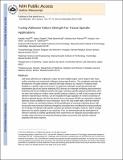Tuning adhesion failure strength for tissue-specific applications
Author(s)
Artzi, Natalie; Zeiger, Adam; Boehning, Fiete; bon Ramos, Adriana; Edelman, Elazer R.; Van Vliet, Krystyn J.; ... Show more Show less
DownloadEdelman_Tuning adhesion.pdf (469.0Kb)
PUBLISHER_CC
Publisher with Creative Commons License
Creative Commons Attribution
Terms of use
Metadata
Show full item recordAbstract
Soft tissue adhesives are employed to repair and seal many different organs, which range in both tissue surface chemistry and mechanical challenges during organ function. This complexity motivates the development of tunable adhesive materials with high resistance to uniaxial or multiaxial loads dictated by a specific organ environment. Co-polymeric hydrogels comprising aminated star polyethylene glycol and dextran aldehyde (PEG:dextran) are materials exhibiting physico-chemical properties that can be modified to achieve this organ- and tissue-specific adhesion performance. Here we report that resistance to failure under specific loading conditions, as well as tissue response at the adhesive material–tissue interface, can be modulated through regulation of the number and density of adhesive aldehyde groups. We find that atomic force microscopy (AFM) can characterize the material aldehyde density available for tissue interaction, and in this way enable rapid, informed material choice. Further, the correlation between AFM quantification of nanoscale unbinding forces with macroscale measurements of adhesion strength by uniaxial tension or multiaxial burst pressure allows the design of materials with specific cohesion and adhesion strengths. However, failure strength alone does not predict optimal in vivo reactivity. Thus, we demonstrate that the development of adhesive materials is significantly enabled when experiments are integrated along length scales to consider organ chemistry and mechanical loading states concurrently with adhesive material properties and tissue response.
Date issued
2010-07Department
Institute for Medical Engineering and Science; Harvard University--MIT Division of Health Sciences and Technology; Massachusetts Institute of Technology. Department of Materials Science and EngineeringJournal
Acta Biomaterialia
Publisher
Elsevier
Citation
Artzi, Natalie, Adam Zeiger, Fiete Boehning, Adriana bon Ramos, Krystyn Van Vliet, and Elazer R. Edelman. “Tuning Adhesion Failure Strength for Tissue-Specific Applications.” Acta Biomaterialia 7, no. 1 (January 2011): 67–74.
Version: Author's final manuscript
ISSN
17427061